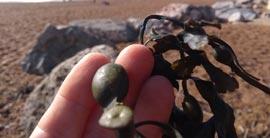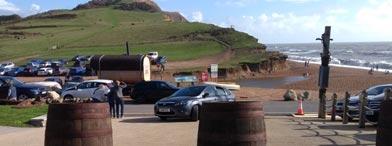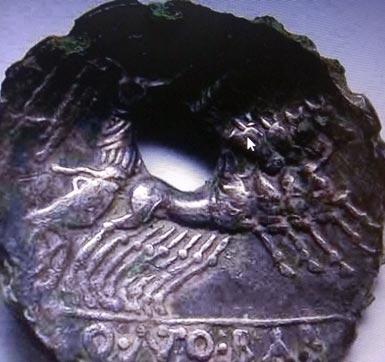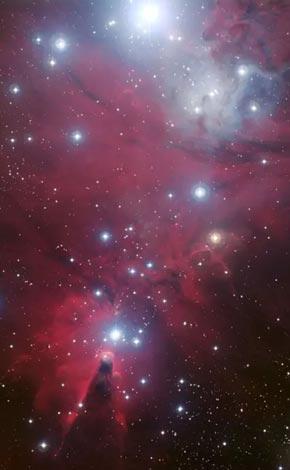
11 minute read
Down to Earth
BEACHCOMBING with JO BELASCO BA Hons History of Architecture and Design
I took my mum to Seatown to get some ocean air. We retreated to The Anchor Inn when the heavens opened. Leaving mum with a cuppa I scrutinised the clues seeping out of the walls in the form of framed certificates, photos and paintings. Beachcombing pointers such as East India Company cash tokens from Victorian wrecks. They looked like they were made of metal (made a mental note to self to invest in a metal detector). On another wall I noted tales of smugglers and humpback whales. The rain faded away and so play resumed. I confess we did not find any whittled whalebone, ancient trading coins or smuggler’s booty. It was better than that: Glistening at our feet was a piece of pyrite-encrusted ammonite! Spurred on by our find I went on to unearth three beautifully frosted pieces of sea glass, driftwood crying out to be turned into a name sign and a stiff piece of dried seaweed. I thought I recognised the seaweed as egg wrack. The shapes of the twisted weed were very decorative and I wondered how easy it would be to turn the little air bubbles into beads. As I still don’t know my bladder wrack from my egg wrack it seemed prudent to wear it rather than eat it! At home, first I pierced it –the air pockets were surprisingly nice to make jewellery with. Of course I am thinking in terms of a Fabergé egg rather than poached. The weed was already dry when I found it but wasn’t crumbly at all but more like leather. I started with a very slim needle then graduated to a thicker needle. Looking at different types of needles online I would guess the initial type was a ‘sharps’ needle and then the thicker version was a ‘crewel’ – I confess I am no seamstress. I just cut the ‘eggs’ away from the stems, trimmed the surrounds then pierced them and threaded them on to wire where they will remain until I find the right type of permanent thread. The staff at The Anchor Inn had been so welcoming we went back for lunch. I was very curious to see whether any type of seaweed was on the menu. Not yet, maybe next time...
Advertisement
SHORE FINDS: Eggwrack seaweed and hematite (for weight) bead necklace, partially pyritised ammonite and seaglass, driftwood at Seatown and, top right, turning the air bubble egg wrack into a seaweed bead piercing it with a needle. Right: Dried eggwrack seaweed
SEA VIEWS: View from The Anchor pub showing The Seaside sauna haus
Hatching jewellery out of eggs found on the shoreline

The West Dorset Magazine, November 18, 2022 45 Down to earth A real spike in number of hibernating hedgehogs
Sally Cooke lives in Tolpuddle with her husband, two grown up sons and her spotty rescue dog. You can follow Sally on Instagram at Sparrows in a Puddle
I bumped into a neighbour recently just as she was taking her two ancient tortoises to the vets for their pre-hibernation check-up. As I peered into the cardboard box to see them it reminded me of watching Blue Peter in the 1970s, enthralled as the presenters boxed up Freda the tortoise for her long winter sleep. I’ve never had a pet tortoise but the wild grass snakes and slow worms that I’ve been lucky enough to see in my garden during the summer will probably have already found somewhere deep under the fallen leaves or rotting logs to spend the winter. Although we tend to loosely use the word ‘hibernation’, the shutting down of bodily functions undertaken by reptiles and amphibians is called ‘brumation’. The mild weather we’ve had so far this November has meant that there are still many insects about, but they too will soon be looking for safe places to overwinter. I’m careful to avoid the temptation to ‘tidy up’ my garden too much as the messy bits of dying vegetation, hollow stems, dry seedheads and piles of leaves are vital places for our summer pollinators to hide away. One of Dorset’s true hibernators, and one that I’ve been thrilled to have visiting my garden all summer, is the hedgehog. About this time of year, especially if the temperatures start to drop, they will be looking for somewhere dark and cold such as a log or leaf pile, or under a garden shed or in a hedgehog house, to hibernate. I am very much hoping that this is what my hedgehog is doing as the saucer of cat biscuits I’ve been putting out each evening, to supplement its natural diet of worms and beetles, has not been touched for a week or so. Hedgehogs may be hibernating now until early spring, so it’s really important to check any bonfire piles carefully before lighting (ideally move the entire heap) and to try and leave log and leaf piles alone. The British Hedgehog Preservation Society website has masses of information on our endangered hedgehogs as well as advice on how to become a Hedgehog Champion and work with your neighbours to create a Hedgehog Street.
Attack of the green jelly blobs in our garden paths
JOHN WRIGHT is a naturalist and forager who lives in rural West Dorset. He has written eight books, four of which were for River Cottage. He wrote the awardwinning Forager’s Calendar and in 2021 his Spotter’s Guide to Countryside Mysteries was published.
One thing that most people know is that bacteria are so small that you need a serious microscope to see them at all and an electron microscope to see them clearly. E coli, for example, averages at 1.5 microns long and half a micron in diameter, meaning that you could arrange 700 end to end in one millimetre. While there a rare few bacteria that are just about visible to the naked eye, there could easily be some in your garden that you might trip over, or at least, slip up on. It is Nostoc commune (=gathered snot) and takes the form of blobs of green/brown jelly nestling in the gravel of a million paths throughout the Kingdom, usually in the wet of autumn. They are greeted with a mixture of puzzlement and disgust by their reluctant custodians, but I think them worthy of examination. The individual ‘blobs’ are not, of course, gigantic, individual bacterial cells, but colonies of billions of bacteria. While they are, indeed, bacteria, they are cyanobacteria, otherwise known as ‘blue-green algae’. ‘Algae’, I must point out, is an informal term for many slimy organisms, regardless of whether or not they are closely related on the tree of life). So, N. commune, is a colonial species of cyanobacterium. The individual cyanobacterial cells that constitute each blob are almost spherical and, under a microscope, they are seen as innumerable, short, intertwining strings of beads. The overall jelly texture is down the polysaccharides that connect and protect these strings. Cyanobacteria are outstandingly self-sufficient, being able to both photosynthesise and fix nitrogen, the latter talent encapsulated in ‘heterocysts’ that occur at intervals along the strings. They can grow on bare rock and contain pigments that protect from ultra-violet radiation. Effectively, it is a colonising species of bare ground, hence its fondness for gravel paths. Nostoc species are also found as one of the symbionts of certain lichens. Most lichen are fungi mixed with algae (completely unrelated to Nostoc), the algal component doing the photosynthesising. However, a few use Nostoc species to perform this function, and, rather than being mixed-in with the lichen’s fungal structure, form their usual blobs which are ‘plumbed-in’. People always ask me if something is edible and, in this case, and despite the fact that some people eat it, I am going with a firm ‘no’. Some cyanobacteria are very dangerous and who wants to eat a green jelly blob anyway?
PAGAN VIEWS by JO BELASCO
‘The Girl with the Chariot Medallion’ – that is what the Celtic female was dubbed when she was discovered in her burial finery. She doesn’t sound so cool as say, The Girl with the Dragon Tattoo or The Girl who Kicked the Hornet’s Nest. However, Stieg Larsson could definitely make a great story from her short life around Langton Herring when the Romans were invading in the first century AD. Her grave was discovered in 2010. The grave goods indicated that she was a woman of great importance. I say woman as her age at death has been calculated at 19 to 25, not really a girl especially in Celtic times. So let’s call her a woman and call the medallion what it really was – a coin which had been ‘drilled’ to make a pendant. And not a Celtic coin with a horse on, of which there were many. But a Roman coin. Many chieftains were buried with their horses and chariots so they could make that journey to the underworld or their next life. I think our Celtic woman died with ‘her boots on’ from battle wounds (that is also consistent with the Wikipedia information). Her chariot was probably irreparably damaged and her horses dead. Horses were the modern equivalent of cars to the Romans and to to some extent the Celts although the reverence the Celts had to horses was more a religion. To have a single chariot was like having a Ford Focus – to have a chariot drawn by four horses was a Porsche and a battle advantage. Sadly, she had no horses or chariot to take her to the next world – or did she? The more I researched about the coin the more I heard ‘the girl’ laughing down the centuries. It was a Roman coin minted to commemorate or bring luck to Quintus Antonius Balbus in a battle. The coin shows the Roman goddess Victory driving a chariot with four horses. The Romans lost and Balbus died – you can see how the Celts would find this amusing. A silver coin minted with all the pomp and propaganda that entails and then after all that – failure. So to then drill a hole in that coin and commandeer the chariot to parade her to the next life is really sticking two fingers up at the Romans. If I got to choose Stieg Larsson’s title for a book about her I would call it The Woman who commandeered the Roman Chariot.

CURRENCY: The actual Roman coin, a Denarius Serratus, found in the grave of The Girl with the Horse Medallion
Money talks from beyond the grave as chariot girl rides out
The West Dorset Magazine, November 18, 2022 47 Down to earth Stunning sights out in Andromeda
Kevin Quinn is a Dark Sky Custodian for the Cranborne Chase Dark Sky Reserve who lives in Piddletrenthide. Read his blog at theastroguy.wordpress.com
It occurred to me that my recent articles have been somewhat broad in nature, so I felt that it was time to explore some specific, must-see highlights that one can observe at this time of year. Although Mercury and Venus are too close to the sun at the moment, the remaining planets are still visible, though Saturn will dip lower in the southwest over the coming months. Uranus reached opposition on November 9, Mars on December 8 (Jupiter and Neptune oppositions have passed). Whilst Jupiter and Saturn rightly steal the show on an observing session, there’s something special about seeing the ice giants with one’s own eyes. Although relatively large, they’re a long way off in the vastness of the outer solar system. At a recent talk I gave to a Cub Scout group, I gave an indication of the sizes and distances involved with the analogy that if the earth was the size of a cherry tomato, Uranus would be an apple about 3.5km away, and Neptune a lime about 5km away. Mindblowing! Naked eye/ binocular must-see objects have to include the Pleiades and Hyades, clusters of several hundred stars in Taurus that are just stunning in a pair of 10x50s. Then there’s
Melotte 20, a cluster of around 100 stars centred around the bright star Mirfak in
Perseus. Also in Perseus is the famous, and doubly stunning, Double Cluster (NGC 869 & 884). One of my favourite clusters is NGC 2264 the Christmas Tree Cluster, a large and bright grouping of around 80 stars spanning about 20 light years and lying around 2600 light years away in Monoceros (to the left of the universally recognisable constellation of Orion). No must-see list would be complete without mention of the Andromeda galaxy. Although very high up at this time of the year, it’s definitely worth a look, and just knowing where it is/how to find it bestows a great sense of achievement that never really goes away. Telescope owners should definitely take a look at galaxy NGC 891 in Andromeda. Not an easy find without a go-to setup, this super sharp edge-on spiral, surrounded by stars and with a dark dust lane down the middle, is a stunner. As is NGC 2841 (the Tiger’s Eye galaxy) in Ursa Major. Around 46 million light years distant, and around 50% larger than our Milky Way. My ambition for the dark winter nights is to spend some time sketching these galaxies, along with the two-for-one Messiers 81 & 82 galaxies (also in Ursa Major). These, of course, are just a few personal favourites. Looking further ahead, it’s hoped that there will be a bright naked eye comet gracing the morning skies. Comet C/2022 E3 (ZTF) is looking like it might rival the recent Comet Neowise. Fingers crossed.





